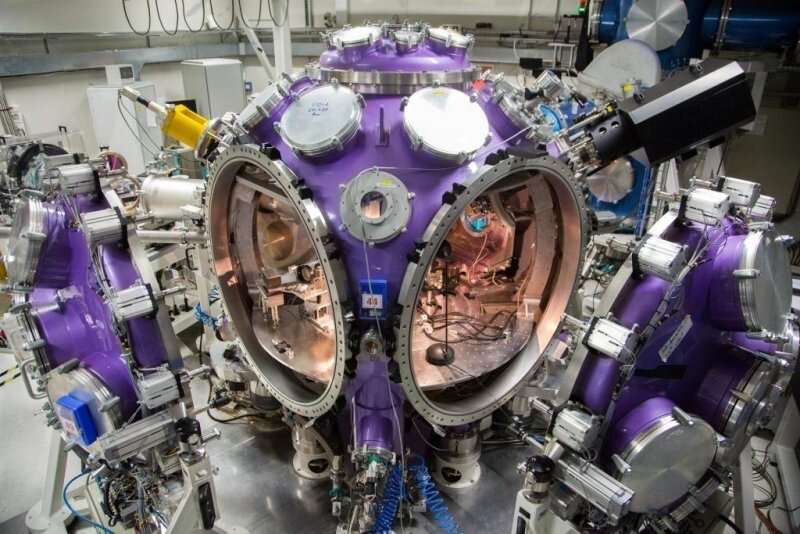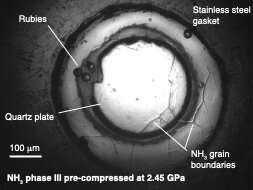July 10, 2023 feature
This article has been reviewed according to Science X's editorial process and policies. Editors have highlighted the following attributes while ensuring the content's credibility:
fact-checked
peer-reviewed publication
trusted source
proofread
Study reports melting curve of superionic ammonia under icy planetary interior conditions

Icy planets, such as Uranus (U) and Neptune (N), are found in both our solar system and other solar systems across the universe. Nonetheless, these planets, characterized by a thick atmosphere and a mantle made of volatile materials (e.g., hydrogen water, ammonia, etc.), are the least explored class of planets; thus so far little is known about their origin, interior structure and composition.
The Voyager probes, two robotic systems launched by NASA on a quest to explore the outer solar system, recorded interesting measurements suggesting that icy planets have peculiar magnetic fields. These measurements showed that unlike other types of planets, such as terrestrial planets and gas giants, icy planets do not have a dipolar magnetic field, and are thus without clear North and South magnetic poles.
Researchers at Ecole Polytechnique, Sorbonne Université and other institutes in Europe recently carried out a study aimed at better understanding under which form matter could exist inside these widely unexplored planets. Their paper, published in Nature Physics, specifically reports the melting curve of superionic ammonia in conditions similar to those that astrophysics expect to find inside U and N.
"The atmospheric composition of U and N suggests their mantle are made of a complex mixture of C, H, N and O atoms, which could also be expressed in a mixture of water (H2O), ammonia (NH3) and methane (CH4), the so-called 'planetary ices'," Jean Alexis Hernandez, one of the researchers who carried out the study, told Phys.org.
"However, the lack of thermodynamic data on these compounds and their mixtures at the extreme conditions (several millions of times the Earth atmospheric pressure and several thousands of Kelvin) of U and N impedes current geophysical models of these planets. Most current models consider that the mantles are made of pure water and the effect of other compounds is still unknown."
Theoretical studies have predicted that at extreme conditions, such as those one would expect to find inside icy planets, water and ammonia could form superionic phases. In these states or phases, H atoms become highly diffusive and move in ways that resemble the motion of fluids, while the remaining atoms (i.e., O and N), remain still in a crystalline lattice.
"Recently, Millot and co-authors have experimental shown the existence of superionic water and determined its melting curve," Hernandez said. "Our work is an analogous experiment but for ammonia. Our experiment was done at the LULI2000 laser facility in France, using a technique called laser-driven shock compression."
Laser-driven shock compression, the technique that Hernandez and his colleagues used in their experiments, essentially consists in generating a shock wave inside the sample using a high-power laser pulse. As this shock wave moves through a sample, it increases both its pressure and temperature.
The transit of the shock wave lasts a few nanoseconds (i.e., a few billionths of a second). During this short amount of time, the researchers measured both the shock velocity and the temperature (T) of the sample. They then related the velocity of the shock to the pressure inside the sample, using an internal standard, specifically quartz.
"The P-T conditions in the shocked sample depend on its phase (its structure)," Hernandez said. "For a given phase, all possible P-T conditions that are reachable by shock lie on a single line that is called a Hugoniot curve. So, when there is a phase change during the shock propagation, the P-T conditions will first follow the Hugoniot of the first phase, then follow the P-T boundary between the two phases, and finally reach the Hugoniot of the second phase."

During the team's experiment, the shock wave sent through their sample transformed ammonia into a dense fluid. The researchers also observed a kink in the evolution of the pressure and temperature during the propagation of the shock.
"This kink corresponds to the moment when the P-T conditions in the sample stop following the Hugoniot of the fluid phase and start following the boundary with the superionic phase," Hernandez said.
"These results were supported by atomistic simulations done by our co-authors. These simulations based on quantum mechanics reproduced the behavior of ammonia at the experimental conditions. The simulations were able to reproduce accurately the experimental observables. Based on this agreement we used them to obtain microscopic insights on how the N and H atoms are behaving at such conditions and determine the conductivity the fluid and the superionic state of ammonia at conditions relevant for Uranus and Neptune."
Producing shock waves at conditions such as those that might be found inside U and N was a challenging task. This is firstly because to produce a strong shock a sample should either be solid or liquid in its initial state (i.e., before the shockwave enters it), yet ammonia is gaseous at ambient temperature.
As a result, the researchers first had to either liquify or solidify ammonia. To complicate things further, even after ammonia is liquified (either by cooling it or pressurizing it), the shock in the sample raises the temperature significantly, reaching far more extreme conditions than those inside U and N.
"To tackle these two challenges, we had to first pre-compressed ammonia up to 3 GPa (30000 bars) in an apparatus called a diamond anvil cell," Hernandez said.
"This device is typically use to create high-pressures in a static way by maintaining the sample in a small press with diamond anvils. In our experiment, we had to couple this static pre-compression with our main laser-driven shock compression. Before the shock, we compressed ammonia into a crystalline phase called ammonia-III. We then shocked ammonia-III, resulting into the P-T conditions of Uranus and Neptune interiors."
Via their experiments, Hernandez and his colleagues were ultimately able to outline the melting curve of superionic ammonia up to 300 GPa, in conditions that one would expect to find inside icy planets. This could have interesting implications for future works, while also shedding new light on the possible characteristics of these widely unexplored planets.
"An important result of this study is that dense fluid ammonia as a higher electrical conductivity than pure water, meaning that in the interiors of U and N, fluid regions with higher concentrations of ammonia could have significantly higher conductivity than the surroundings," Hernandez explained. "These variations of electrical conductivity influence the generation or the propagation of the peculiar magnetic fields of these planets."
Better understanding the behavior of pure systems, such as water and ammonia, at high pressures and high temperatures, is a first crucial step towards understanding what happens inside icy planets. So far, Hernandez and his colleagues focused on the melting curve of superionic ammonia under these extreme conditions, yet the mantles of U, N complex mixtures of carbon, hydrogen, oxygen, and nitrogen, which they plan to examine in further studies.
"The determination of the melting curve is also a major finding as we observe a crossover with the melting curve of superionic water between 70 and 100 GPa, meaning ammonia melts at lower temperature than water above this pressure range," Hernandez added. "This is an important input for determining if the extent (if any) of solid or superionic regions inside Uranus' and Neptune's mantles. In future experiments, we will try to gradually explore more complex systems, such as the mixture of water and ammonia."
More information: J.-A. Hernandez et al, Melting curve of superionic ammonia at planetary interior conditions, Nature Physics (2023). DOI: 10.1038/s41567-023-02074-8.
Journal information: Nature Physics
© 2023 Science X Network





















